Categories
© 2021 CarLessOhio.org. All rights reserved.
Promoting the bicycling lifestyle in The Buckeye State
The Cleveland Metroparks has four parks with mountain biking trails. The West Creek Reservation in Parma, Ohio with its 2.7 miles of very beginner-friendly singletrack is the perfect testing ground for new bikes. I took my Bike Friday All-Packa there to ask the question, “Can this bike shred?” Short answer: Yes, this bike can shred.
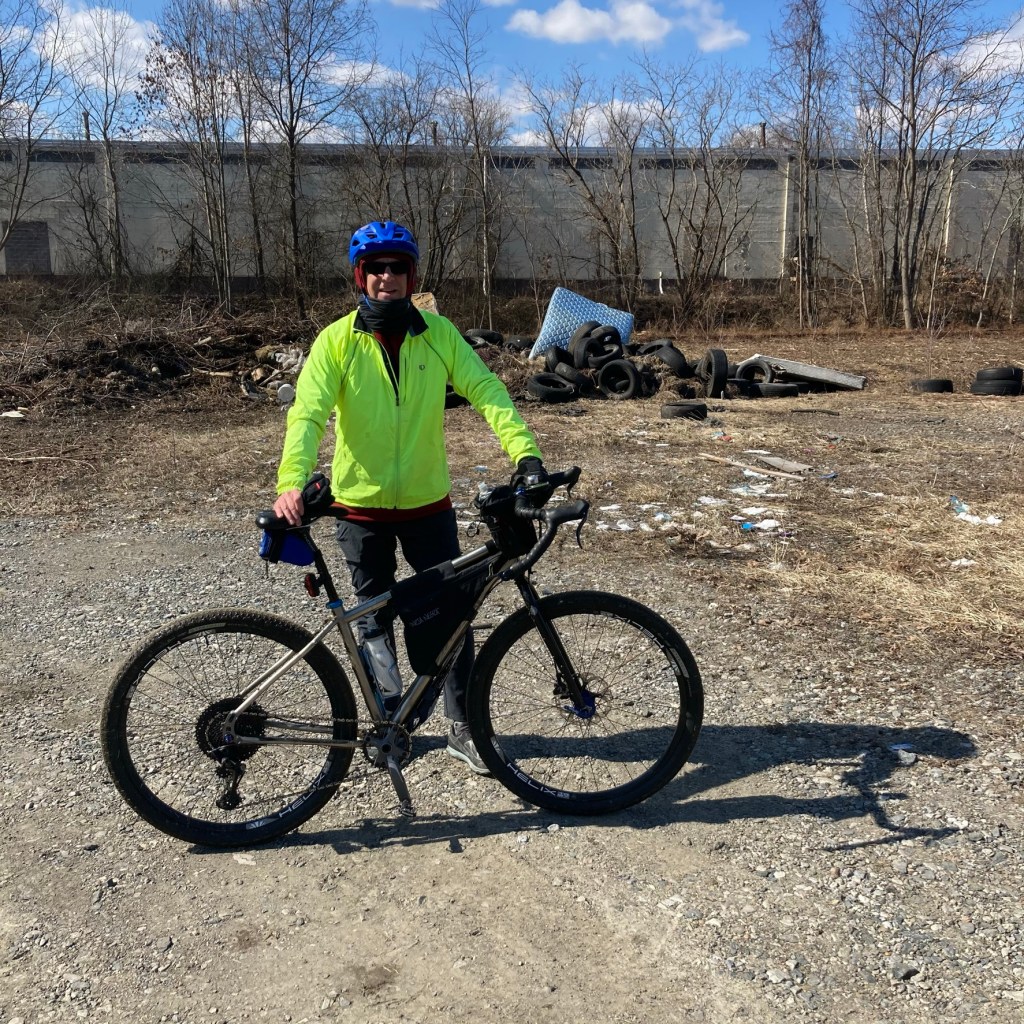
Through most of the winter, I’m usually one of those rah-rah, fat-biking, “there’s no bad weather, just bad gear” type of people. There comes a point during some winters, though, where I finally give in and say “enough is enough.” I’m tiring of always being cold, I’m tired of having to treat every bike ride like an expedition, I’m just plain tired. Rides start to feel forced, where I’m not riding for the fun of riding, but just riding to “get some miles in,” “keep my fitness up,” or whatever.
I ride the indoor training occasionally, but during times when I’m motivated enough to do that, I’m motivated enough to bundle up and get outside. When I reach the giving up point like lately, I almost revert to a total couch-surfer. Sometimes these periods of riding funk occur briefly even during the warm-weather season, when bike rides start to feel repetitive and routine.
Fortunately, though, a day comes along that unexpectedly brings the spark back in my pedals. That day was yesterday. I met my friend Brent at his bike shop with my Salsa Fargo. It was still a fairly cold day; I was bundled up enough to be comfortable, but it wasn’t so bad as to have to be bundled up like Randy from A Christmas Story.
We rode out of Hudson over to the Bike & Hike Trail, in the direction towards the village of Silver Lake. A side street there led us over to Front Street in Cuyahoga Falls, through the downtown area, and onto what’s known as the “Route 8 Gravel.” This is a north-south stretch of service road between State Route 8 and a set of railroad tracks, a common destination for local adventure riders, but I had never been there.
We were worried the gravel road might be too muddy. It was mostly dry packed dirt, but there were some large puddles of water all the way across that we had to ride through. So, the dry dirt stuck to our wet tires. So although technically it wasn’t “muddy,” the end result was mud. It wasn’t so bad as to gum up our tires in the bike frames, though, and it was some fun exploration.


The gravel road ends near the Akron end of the Freedom Trail. We got on the trail and headed the other way to Kent, stopped at a Sheetz for a couple of take-out personal pizzas, snacks, drinks. We got on the Portage Hike & Bike Trail just across the street. A short pedal out and into the woods is the old “Moon Tower,” an abandoned railroad water tower, where we hung out to enjoy our lunch.

A bit further on the bike trail, through housing development, cemetery, school, then a short road jaunt leads back to the Bike & Hike Trail and back to Hudson, which brought me to a little over 36 miles for the day. Not an epic death march, but exactly the kind of casual, fun, exploration ride I needed to recharge my batteries, refresh my soul, and rekindle my love of biking and help me look forward to warmer (and maybe even not so warm) rides to come.
We are bound to get that last “surprise” snowfall of the season. It may come in mid- or late March; it can even come on Easter Sunda. It’s winter’s cover of “Don’t You Forget About Me.” But that’s okay. I’ll be ready for it and for whatever comes after it.
A couple of months ago, I came across some videos from a YouTube star in the backpacking/through-hiking world known as Darwin onthetrail. He occasionally does bicycle touring, and most of the advice he gives and gear he talks about apply equally to bike touring (or bikepacking) as well as hiking.
I had never heard of the concept of “cold soaking” food until I saw Darwin mention it in a couple of his videos. Typically, backpackers and bikepackers carry a stove, fuel, and cooking pot for boiling water to prepare dehydrated food. What you can do instead is put your food with some water in a container a few hours before you plan to eat it. The time allows the food to soak up the water and be reconstituted just as well as when it’s heated and/or boiled. This saves the weight of the stove and fuel in your kit, plus saves time when you get to your camp site and are ready to eat.
I decided to test this out for myself during today’s ride. My route was a nice loop that connects four bike trails: the Ohio & Erie Canal Towpath Trail (in the Cuyahoga Valley National Park and the Summit Metro Parks), the Freedom Trail connecting Akron to Tallmadge to Kent, the Portage Hike & Bike Trail, and the Summit Metro Parks Bike & Hike Trail.
I re-used a container from Talenti Gelato, which is recommended by Darwin, and apparently is a popular option among many other cold soaking enthusiasts. I poured in the contents of a Knorr’s Rice Sides packet, and planned to add a packet of StarKist Tuna. I don’t think the Talenti container is big enough for this particular combination. The Knorr’s instructions on the packet said to use 1¾ cups of water for stove-top cooking, or 2 cups for microwave cooking. I could only fit about 1½ cups of water in the container with the rice mix before it started to get precariously full. I screwed the lid on tight, and gave it some shaking to try to distribute the water throughout the rice mix, but it seemed like the water was already starting to get so soaked up that there wasn’t much distribution going on. The vegetable pieces and powdered seasoning pretty much stayed near the top of the container.
I wasn’t sure how well the lid would hold up under the rigors of being in a bike frame bag (especially with the bumpy conditions on the Towpath Trail due to recent construction work), so I stuck it inside of a plastic resealable bag just in case.
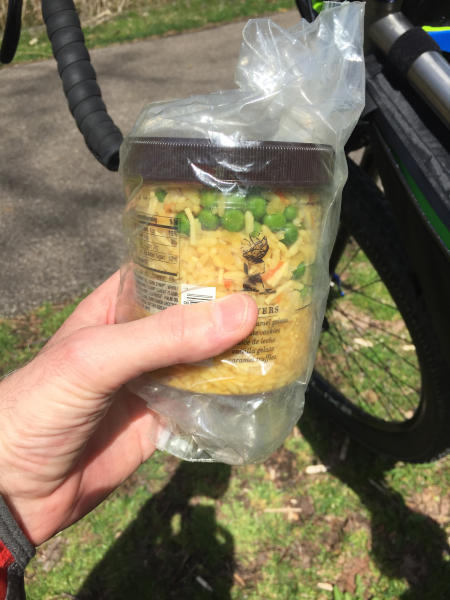
This fit nicely inside of my new Oveja Negra Superwedgie Frame Bag (thanks, Mom!), along with my spoon, cable lock, and garage door opener, with room to spare.
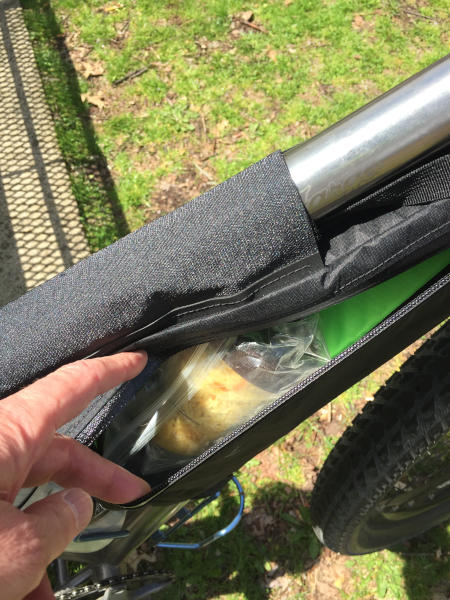
During the ride, I came across a nice, secluded bench on the Portage Hike & Bike Trail, and decided that would make a good lunch spot. I took out my food container and dug in. The lid held up fine; there was no mess in the plastic bag.
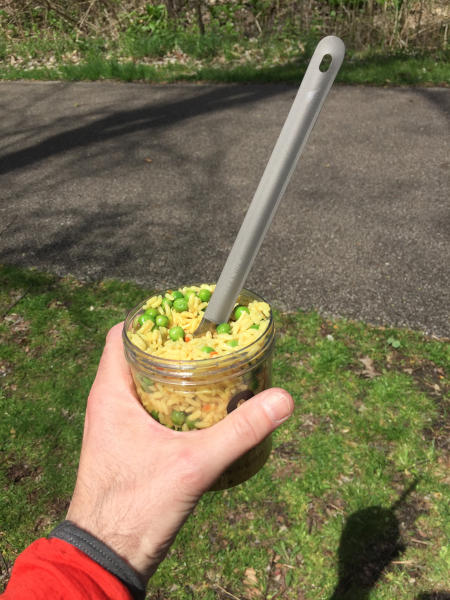
After eating about a third of the rice mix, there was enough room for me to stir in the tuna.

So, the 64-dollar question, of course, is, “How was it?” Surprisingly good, I must say. The consistency of the rice mix and the taste were the same as what I’d expect if they were prepared the traditional way with boiling water. My fears about the ingredients not being able to mix up well enough were unfounded. As I ate, I did not notice any pockets of “no taste” or “too much taste.” The rice soaked up the water well. I would not have wanted to use any less water, as overall, it was just on the good side of “moist enough” to eat.
If I were eating this in the comfort of home, I would probably be thinking, “This is kinda gross.” That’s probably the case with most camp food, though. At this point, I had been on my bike for 3½ hours, and it had been 5½ hours since I had eaten anything at all, so this meal seemed like a gourmet smorgasbord. I’d probably be finding myself in much the same situation any time I used this food preparation method, so I expect I’d feel much the same way every time.
For quality and convenience, I give the concept of cold soaking two thumbs up, and it goes without saying that it fulfills the goal of weight savings. The only downside would be getting used to eating your dinners cold.
If I do cold soaking in the future, I’d likely look for a larger container. Peanut butter jars come highly recommended, or if money is no object, the Vargo Titanium Bot HD would be my first choice. A Hydro Flask 18-ounce Food Flask would probably make a good budget-friendly choice if you’re not into re-using containers from store-bought foods (although it’s a pretty heavy option).
Backpacking stoves and cookware are so small and light these days that for multi-day trips, I’d still stick with traditional cooking methods. The extra stuff to carry is worth it for me to have a hot meal at the end of the day, not to mention hot coffee for breakfast.
Where I’ll likely use cold soaking is impromptu one-night trips, where maybe I don’t have the time to plan my packing list very well, or don’t have the time to set up my bike to carry more than bare minimalist gear. Or, if I anticipate feeling lazy once I get to the camp site. Another situation where I see a big advantage to cold soaking would be an event such as a multi-day self-supported race, where time, in addition to weight, is a big factor.
Should you ride your bike to the mountain bike trailhead?
The short answer is, yes.
Of course, as a driver and cyclist who promotes using your “car less,” I think you should pedal to the mountain bike trail whenever it’s possible and practical. Obvious situations where it’s not practical include “destination” mountain bike trails that are dozens, or even hundreds, of miles away from home.
Deciding when to ride to your local trail can involve a complicated combination of factors. The first time I rode from home to the trail was in the summer of 2010. I had just built a new 29er mountain bike, and was eager to do some exploring in my neighborhood and on some local trails.
At this point in history, the only truly “local” mountain bike trail was in the Cleveland Metroparks Ohio & Erie Canal Reservation (OECR). There was West Branch State Park, a 45-minute drive away; Vulture’s Knob and Mohican State Park, both over an hour drive away; or Reagan Park, local if you happened to live in Medina.
I saddled up and headed out from my then-home in Twinsburg, made my way up to Alexander Road, then west to where it meets the Towpath Trail, then headed north up to OECR. It was about 16 miles before I reached the mountain bike trailhead. Maybe it was the mid-summer heat and humidity bearing down, maybe it was pushing my knobby tires on pavement most of the way, but by then, I wasn’t much in the mood the tackle singletrack. I did one obligatory lap of the 2.5-mile trail, then made the slog back home, resigning myself to not doing that kind of adventure again any time soon.
Fast forward to 2017, and the local singletrack options have exploded. The singletrack in the Cleveland Metroparks Bedford Reservation is a short 3.5-mile ride from my current home. The East Rim Trail in the Cuyahoga Valley National Park is literally on my way to work. The Hampton Hills Mountain Bike Area in the Summit Metro Parks is just south of work, and a short detour off of both the Towpath Trail and the Bike & Hike Trail. The Royalview Trail in the Cleveland Metroparks Mill Stream Run Reservation is a short 30-minute drive away.
There’s a group of local riders who, for the past couple of years, planned a day-long ride of over 100 miles that connects all of these local trails. They call it the “Solstice Ride,” since they plan it on or near the longest day of the year to maximize available daylight. On my bucket list for one of these years…
When I was looking to do some exploring and trail-riding on a cold fall day last Wednesday, most of the local mountain bike trails were closed. However, old reliable OECR is almost always open, so I hopped on the Surly Ogre to make my way up there. Sagamore Road is a nice low-traffic back road that takes you from the eastern side of the Cuyahoga Valley down to the Towpath Trail, near the Frazee House Trailhead.

Ohio & Erie Canal Towpath Trail near Alexander Road

Towpath Trail at the border of the Cuyahoga Valley National Park and the Cleveland Metroparks Ohio & Erie Canal Reservation, near Rockside Road in Independence
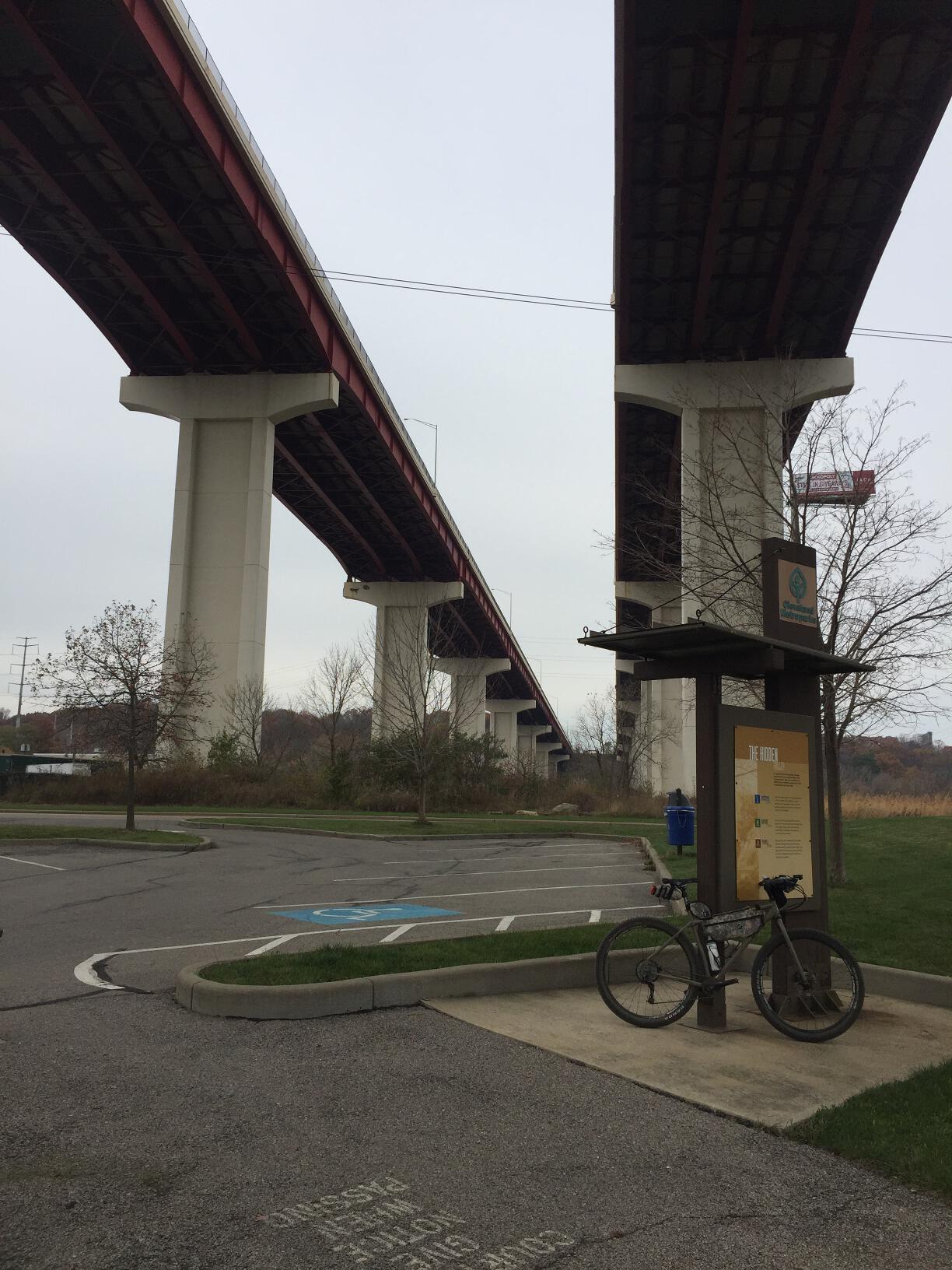
Towpath Trail parking lot under Interstate 480

Near the path up the to Canalway Center

The OECR mountain bike trailhead
It ended up being 13 miles from home to the trailhead. The trail was in perfect shape. After my first lap, I still felt I had some trail legs left in me, so I did a second lap, which meant that would push me up over the 30-mile total mark by the time I got back home. Not bad for a cold fall day. And sometimes, when you hit a brick wall on some activity, some day, some way, you come back to it to turn it into a positive experience.

Suspension bridge on the Towpath Trail in Valley View
Back in 2010, I decided in the Spring that I would run a marathon that year. I looked up a training plan, but that’s about as far as it went.
I do the events and adventures that I do for my own enjoyment, not to impress anyone or prove anything to anyone. But I have to admit, I’d always wanted to run a marathon just so I could check that item off the list, and whenever the subject comes up, I could just sit back, breathe in pensively, and casually say, “Yeah, I’ve done that.”
Running is something I’ve done on and off over the years, just to mix it up and try to do some cross-training outside cycling. Getting back into running after getting away from it gets harder every time. The first few times I run, I think, “This sucks; this is why I don’t do this.” Then, I eventually get my running legs back, and start to enjoy it again, and the thoughts start churning again of, “Y’know, I bet I could do a marathon if I put my mind to it.”
In mid May of 2017, my girlfriend and I signed up for the 10K run in the Cleveland Marathon. Following the race, as we sat in the beer garden and enjoyed a post-race refreshment, I watched as some half-marathon runners arrived, and later some full marathoners. The thought hit me again, “I want to do that.”
The Towpath Marathon is the perennial first-timers marathon. It’s on the mostly unpaved and flat Ohio & Erie Canal Towpath Trail in the Cuyahoga Valley National Park, practically in my backyard. It’s held the first Sunday in October. I made up my mind in early June and registered. So, I had roughly four months to train.
I Googled “four month marathon training plan” and came across something that looked reasonable. I printed it out, hand-wrote the dates for each week, and stuck it up on the refrigerator.
 The plan involved five days of running per week. Fridays were rest days; cross-training with a different type of activity was suggested on Mondays. The longest run of each week was on Saturdays, with short to medium runs the remaining days. The length of the runs reached their peak during the 13th week, then tapered back down during the final three weeks leading up to the race.
The plan involved five days of running per week. Fridays were rest days; cross-training with a different type of activity was suggested on Mondays. The longest run of each week was on Saturdays, with short to medium runs the remaining days. The length of the runs reached their peak during the 13th week, then tapered back down during the final three weeks leading up to the race.
I didn’t want to give up my cycling that much, so I figured I’d plan on running three or four days a week. Working retail, it usually wasn’t practical to do the longest run on Saturdays, so I’d typically do it on my mid-week day off, usually Wednesday or Thursday. I’d do a short run early in the week, and a medium run late in the week, and sometimes squeeze in and extra short or long run on one of the remaining days.
Most of the time, I ran on the Towpath, but sometimes on the streets in my neighborhood, or on some private trails in a housing development adjacent to my neighborhood. Once in a while, I ran on the Buckeye Trail near Peninsula. I like trail running; the non-paved surface does feel easier on my joints, plus it kinda has the same vibe as mountain biking.
The Towpath Trail provided the ideal terrain for training. I have been biking on it for fifteen years, and ride some part of it at least once a week, either as part of my commute to and from work, or just for fun. Name any two points on the trail, and I can tell you the mileage between them. This would help in planning my training runs. A coworker suggested that the Columbus Marathon would be a better “first” marathon. The Towpath has limited access for spectators, so much of the time, you’re running on your own. The Columbus course is also very flat, and being in the city, there are crowds to cheer you on every step of the way. The crowd support is not a big deal to me, and I never get tired of the Towpath scenery.
I still biked a couple days a week; not as much as in a typical year, but enough that I still felt like I was getting my fix. My girlfriend and I signed up to do RAGBRAI, so she was actually riding a lot more than I, often getting in long rides on her own. We rode our only century of the year on July 9, to Massillon and back on the Towpath.
Immediately after returning home from RAGBRAI week, I flew out to Nevada for a work event, so there was basically two weeks of ignoring the training plan, although riding about 60 miles a day for seven days straight across Iowa kept me in good cardio shape. I worked back into the plan somehow without falling too far behind.
Some people register for a half-marathon and train for it. My first half-marathon was just another inauspicious check-mark on the training calendar, and it came on August 17. It was a cool day for August, with a light misty rain. I actually felt the worst that I had ever felt on a training run; I think mainly because I underestimated the water and snacks that I’d need. I ran from home, with the plan to being to meet my girlfriend at the Rockside Road trailhead on the Towpath. I ran through a couple of the local neighborhoods, then hooked up with the Sagamore Creek Trail, which was more overgrown with weeds than I expected, so the required bushwhacking slowed me down a bit. I got on the Towpath at the Frazee House Trailhead. When I got to Rockside Road, I was still a bit short of the needed miles, so I continued north on the Towpath. I’ve biked that stretch dozens of times, and it seems to go in the blink of an eye, but running it for my last mile seemed to take forever, all the while as I was doing the mental calculations for when I needed to turn around to get exactly 13.1 miles. The upward slope of the first of the trail’s suspension bridges loomed before me, but fortunately, I reached my turn-around point just before I got to the base of the bridge. Back at the parking lot, it was 13.1 miles exactly when I reached my girlfriend waiting with her car.
In the later weeks of training, the medium-length runs were starting to get long enough that I’d have to get up extra early to do them before work. It was still dark in a couple of cases, although never enough that I had to resort to running on the Towpath with a headlamp.
I believe I hit my physical peak on the day of my training mileage peak. On September 13, I did a 20-mile run on the Towpath, and felt fantastic. I even toyed with the idea of just running an extra 6.2 miles and getting it over with.
My food and drink plan for training runs was pretty simple. For any run over five miles, I’d bring a water bottle with a hand holster. I’d eat a packet of GU every 5 miles. Running on the Towpath afforded places to refill the water bottle, usually at the Boston Store Visitor Center and the Hunt Farm Visitor Center. Post-run, I’d recover using protein powder mixed in milk with some Hershey’s chocolate syrup to make it more palatable. I tracked my runs using Strava on an Apple Watch 2. I found that I only had any chafing issues on runs of about 8 miles or more. So, on those runs, I started using Body Glide. My shoes were a pair of New Balance 481 trail running shoes. I had a pair of Pearl Izumi eMotion Road M3 shoes for street running.

I wasn’t training for speed; I just wanted to get the miles in. Occasionally, though, I would do some interval work by sprinting for about 50 yards every mile or two. My goal for the race was to beat five hours.
The final week prescribed the last training run of two miles, three days before the event, followed by two days of rest. I ran those two miles in the early evening on Thursday, October 5, and ironically, it was probably my second-hardest training run, after the half-marathon run. I picked up my packet and race bib number without incident on Saturday at Boston Mills Ski Resort.
 Race morning was the typical routine. Wake up before the crack of dawn, eat some yogurt and granola for breakfast, get dressed and get in the car to head to the race. My girlfriend signed up for the 10K race, and fortunately, the start and finish for both the marathon and 10K were close to Boston Mills, so we didn’t have to deal with any funny business of drop one another off, or taking a shuttle before or after the race. We got there in time to park at Boston Mills, took our last-minute bathroom breaks, and walked a bit up Riverview Road to the starting area.
Race morning was the typical routine. Wake up before the crack of dawn, eat some yogurt and granola for breakfast, get dressed and get in the car to head to the race. My girlfriend signed up for the 10K race, and fortunately, the start and finish for both the marathon and 10K were close to Boston Mills, so we didn’t have to deal with any funny business of drop one another off, or taking a shuttle before or after the race. We got there in time to park at Boston Mills, took our last-minute bathroom breaks, and walked a bit up Riverview Road to the starting area.
While waiting for the start, I had an interesting conversation with a pace runner. I don’t remember what pace the guy was setting, but he said he had run the Towpath Marathon a few times before, and this was his first time being a pacer. I asked him how he kept a consistent pace. He said that he set his GPS watch to show his pace as one of the data fields on the screen, and just keeps an eye on it to stay within range. He also said, though, that some experienced runners just have a natural ability to keep a chosen pace. He had a trainer that he worked with in the past, and she had this ability. She would say, for example, “Okay, today we’re doing eight-minute miles,” and she did not use any technological aids. Sure enough, following the training run, his GPS report would indicate that’s what he did, within a couple of seconds.
At the starting horn, we ran south on Riverview Road, turned left onto Boston Mills Road, then made a right onto the Towpath Trail. As I headed south, it seemed like the other runners around me were so serious and quiet, so as we went through the railroad tunnel about a mile north of Peninsula, I let out a bit “Whoop-whoop!” and a few other people chuckled and joined in.
The turnaround point was just a bit south of Ira Road. Along the way, I used the rest stops to top off my water bottle, and grab a GU, banana, or peanut butter and jelly sandwich. A couple miles south of Peninsula on the return, I hit the half-marathon mark and was still feeling pretty good (and that ended up being a personal best for a half-marathon).
I distinctly remember the point where I started to hit a wall. It was between the Ohio Turnpike overpass and the Boston Store Visitor Center, around the 16-mile mark. My legs started feeling tired; my feet started feeling heavy. I just thought, “10 miles sounds like a lot, but you can push through it.”
The northern turnaround was the trail loop under the State Route 82 bridge. As I approached the Station Road intersection just before that, I was happy to see my girlfriend there cheering me on. After her 10K, she had time to go home, shower, eat lunch, and get back to the course to see me.
Following the turnaround, it was about five miles to go to the finish. My pace had slowed considerably, but other than snack and bathroom breaks, I kept running the whole time. During the last stretch between Highland Road and Boston Mills Road, my “running” was barely a trot. I came upon a woman who appeared to be in her 70s, who was alternating between running and walking, but I couldn’t keep up with her.
I finally arrived in the parking lot of the Boston Store Visitor Center and crossed the finish line, making my five-hour goal with about 3 minutes to spare. My girlfriend was there and managed to get a cell phone snapshot.
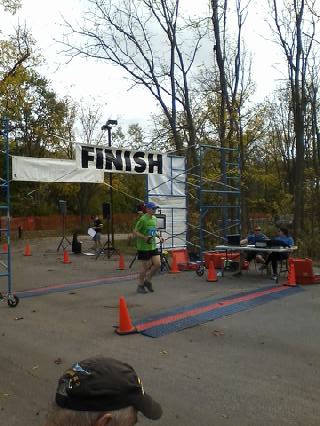
The finish was followed up by some recovery snacks and a celebratory beer, then a celebratory cake at home (my favorite, Boston Creme).

The next day for work, I decided that yes, I would “be that guy” and wear the race t-shirt the day after the race.

So, yes, I learned that if I put my mind to it, I CAN run a marathon. Of course, I also learned that “putting your mind to it” is the real trick in the process. Running a marathon is easy; it’s training for a marathon that’s hard.
Ask just about anyone, and they would say the soul of a bicycle resides in the frame. Tires, brake pads, chains, cassettes, and chainrings are worn and replaced. Shifters and derailers get upgraded as we experience component group envy. But the heart and soul of the bike remains the beloved and recognizable frame.
I would usually agree with this assessment, but my experience with some of my favorite bicycles over time tells a somewhat different story.
Early in my life as a “serious” cyclist, I obtained my first decent mountain bike, and a few months later, my first decent road bike. For a few years, I thought I had all the bases covered.
About six months into my career in the bike industry (around March of 2005), the snowy Northeast Ohio weather started to break, and I began to consider how I would commute to work by bike. Since the 7-mile route from my apartment to the shop was all on-road, my road bike was the natural choice.
The first day I rode to work, we happened to get a freak late-season snow shower (one of many to come that year). I saw how sketchy a 700×23 tire can feel with even a light layer of snow. I also quickly realized that even with a day’s worth of cargo consisting of lunch and a change of clothes, a pure road bike really sucks at hauling around any amount of cargo.
The next time, I tried my mountain bike. I handled varying weather and road conditions much better, and even with just a seatpost-mounted cargo rack, it was a little better at carrying stuff. But the wide, knobby tires just felt like such a drag, even for short trips. I ride real mountain bike trails on a regular basis, so constantly swapping tires wasn’t a viable option.
Any person who decides to live the “bicycling lifestyle” comes to the conclusion that you need a “practical” bike. A bike that is relatively light, but not too light so as to get noodly when hauling stuff. Something that can fit relatively wide tires, but not too wide. A bike that feels just as good for a quick jaunt down to the store as it does on an all-day slog.
At the time, my shop carried Bianchi bicycles, and one of the best-sellers was the Volpe.
The Volpe was marketed as a “cyclocross” bike, but in reality, it was more of a light-duty touring bike. Triple crankset, Shimano Tiagra STI shifters, 9-speed mountain cassette, and un-flashy but dependable Shimano Deore rear derailer. It came with WTB All-Terrain 700×35 tires, which rolled well on pavement despite their aggressive appearance, but also had enough tread to handle dirt, gravel, and other mixed-surface riding before anyone had ever come up with the idea of a “gravel bike.” With a tall head tube, the bike’s geometry provided an upright position for long days in the saddle, well before “endurance road” geometry was “a thing.”
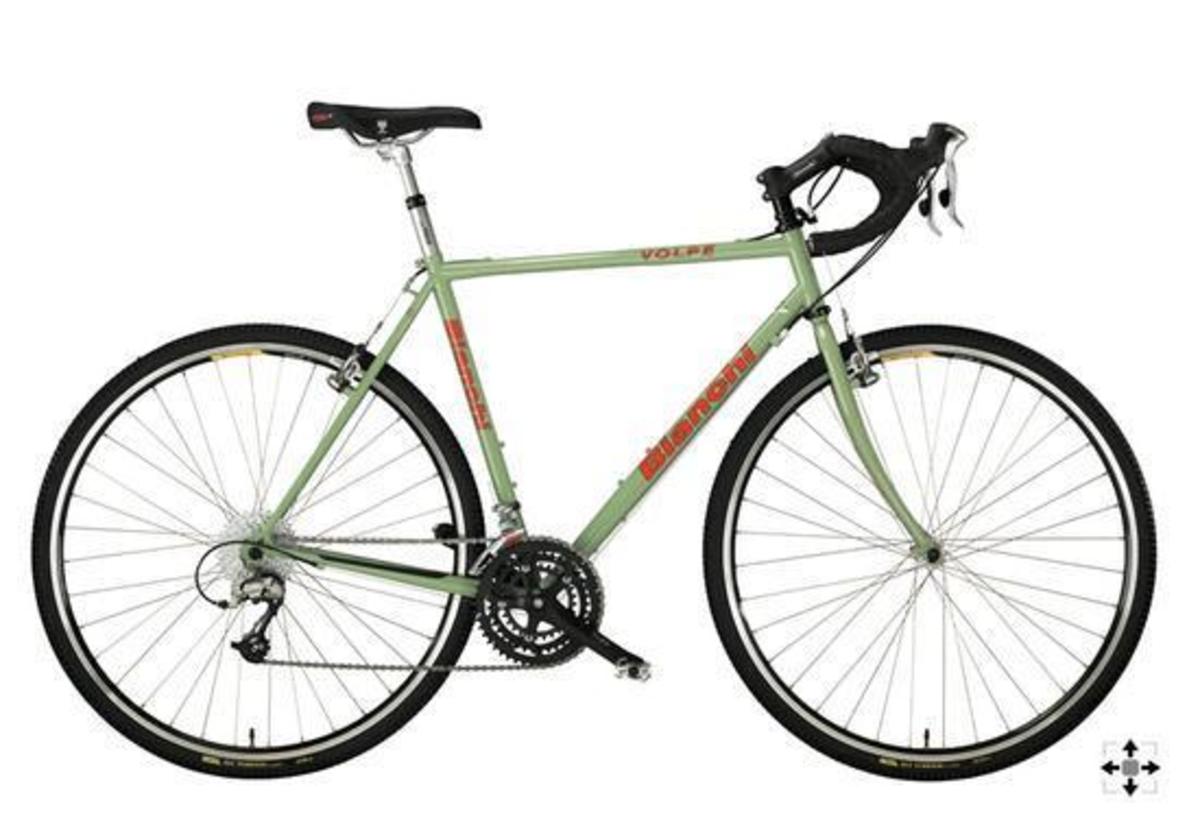
The stock 2005 Bianchi Volpe
The color of the bike was a pale green called “Dirty Celeste,” a riff on the traditional bright-blue Bianchi Celeste that said this wasn’t a thoroughbred race bike; it was bike that you could play in the dirt with. This bike was your buddy that you’d go have a beer with.
The Volpe proved to be the ideal commuter bike that I was after. To my surprise, though, it didn’t take long for it to become my go-to bike for any ride that did not involve being timed by a clock or somebody counting laps. That summer, I rode it on my longest single-day ride ever, 151 miles from Chagrin Falls to Pittsburgh. The fit and feel of the bike encouraged exploration, heading out when you never know where the road might take you, or where the road might even end. I ended up doing more bike commuting that year than probably any year before or since, logging many days of my 7-mile route between Chagrin Falls and Solon, sometimes going for two weeks at a time without getting in my car. I swapped those stock WTB tires out for Continental Gatorskin 700×28, which were a little more zippy for pure road riding, and adequate for unpaved trails like the Towpath.
Later that year, I rode the Volpe in my first Dirty Dozen in Pittsburgh. In 2006, I shipped it out to Seattle for a weekend mini-tour for the Adventure Cycling Association’s Leadership Training Course. I rode it in my first and only RAGBRAI. I rode it 120 miles to my mom’s house one day and back the next day. I borrowed a cargo trailer and rode it to Kelleys Island and back.
Following that trip to Seattle, I got to thinking that this bike-touring thing might be something I’d like to get more into, so I should get a bike that makes it easier to pack up and ship it across the country. In the fall of 2006, I bought a Surly Long Haul Trucker frameset and had it split in half and S&S couplers put on my Bilenky Cycle Works. I used that bike for several overnight tours over the years, but only ever ended up doing one long bike tour where I packed it up in its travel case and checked it on a flight (a 9-day tour in southwestern New Mexico in September 2007). The Volpe remained my go-to bike for long days in the saddle around home.
I originally built the Long Haul Trucker with a compact double crankset (50/34-tooth), but soon realized that carrying heavy loads, I’d need a traditional touring triple. So, I swapped the crankset, bottom bracket, and front derailer between the Volpe and the Trucker. The compact double was perfect for a light-load-carrying exploration bike like the Volpe. Other minor component upgrades came along: Salsa Shaft seatpost, Salsa Cromoto stem, and Salsa Bell Lap handlebar. At some point, I swapped the stock Shimano cantilever brakes out for Avid Shorty 4, not because the Shimano didn’t perform well (they did), but because I thought the black Avids looked better than the silver Shimanos.
The Volpe’s red logo accents tempted me to bling the bike out with all manner of other red accents. I resisted this urge until some time in 2007 when a co-worker gave me an old GT front mountain bike hub in anodized red. I searched eBay for a matching rear hub, and eventually one from Sun Ringle turned up (the shades of red weren’t exactly the same, but on the bike, it was close enough). I bought a pair of Salsa Delgado Cross rims and had them built into wheels, with red Salsa Flip-Offs skewers to top them off. More red followed … headset, bottle cages, handlebar tape, seat bag, and even brake pads. I had joined the Dark Side of color-matching weenies, and the green and red scheme gave the bike its nickname: Saint Nick. This is the best photo of have of the bike in that setup, with some, but not all of these changes:

I did my second Dirty Dozen Race in Pittsburgh with the Volpe in this configuration in November of 2007. The compact double crank was adequate for humping up all of those steep hills.
Some time in 2008, I had my eye on a Surly Cross-Check, because a few of my friends had them, and it just seemed like a cool bike. Another friend from looking at a new Bianchi Volpe. She test-rode mine and loved the fit and feel, but didn’t like the color currently available at that time. So, I took that opportunity to sell her my Volpe frame and fork. I took all the components and put them on a new Cross-Check frame. The color available at the time was Misty Mountain Grey, which I was kind of on the fence about whether I like it or not. The red stuff looked pretty nice on it, though. At one point, I even had some red fenders on it, plus the Surly provided the opportunity to use a red seat post collar.
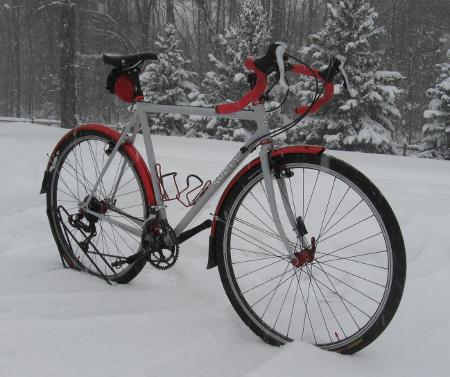
The off-white and red color scheme made me choose a new nickname, the “Ghost of Saint Nick.” At this point, the only components that were original from the Bianchi Volpe were the Shimano Tiagra brake/shift levers and the WTB saddle. But, this bike took over duties from the Volpe without a hitch. Surly’s top-rated chromoly steel frame and fork provided the same comfortable ride for long days on the road the same as I’d come to know and love from the Volpe. So I regarded this bike as having the same “soul” as the Volpe.
I rode the Cross-Check on many long rides once again, such as my first Bike MS Pedal to the Point, a ride to the Pennsylvania state line, and others.
Late in 2011, nearing the end of my first season of owning my Salsa Fargo, I found I was using the Fargo for touring, and the Long Haul Trucker was collecting dust. Meanwhile, with fenders on the Cross-Check, and usually a rear rack for hauling stuff around, the Cross-Check was beginning to look more and more like the Long Haul Trucker. So I figured, why not just swap all the components from the Cross-Check onto the Long Haul Trucker, and make the Trucker my “all day road rides” bike? So it came to be.
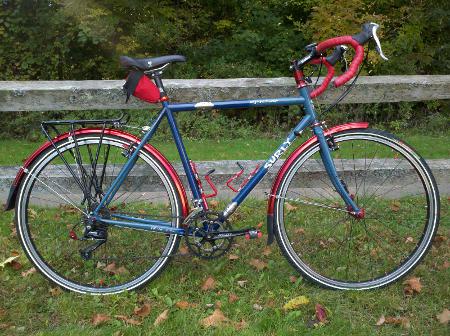
I had mixed feelings about the red parts on the blue frame … a little too much color. The bike was definitely comfortable, but it didn’t have the same “zip” as the Cross-Check.
Meanwhile, the Cross-Check got converted into a singlespeed:

This bike was fun; I did one cyclocross race on it, a long Towpath ride (Peninsula to Bolivar and back, about 120 miles), and some cruises around the neighborhood.
But I found that I was “missing” having a regular Cross-Check. In early 2013, I bought a Black Cross-Check frameset and put all the red parts on it. The Grey Cross-Check went on the selling block, and the Long Haul Trucker got converted back into a true touring bike (black components, triple crankset, bar-end shifters).
The new Cross-Check welcomed back a familiar feeling; I was happy on the road again, and the black frame murdered out with all the red parts really turned heads.
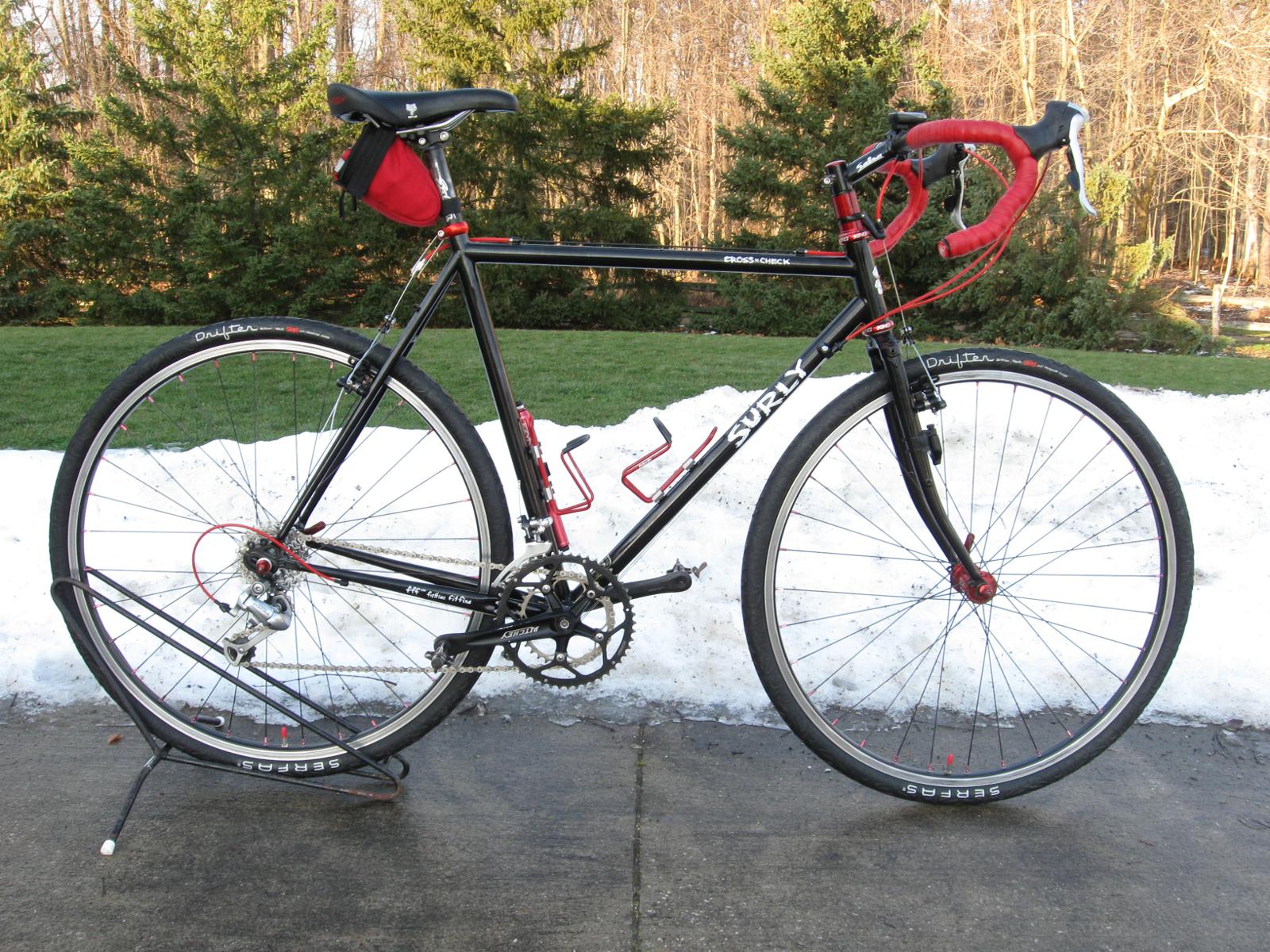
This iteration of the bike later saw upgrades to a Thomson stem and seatpost, Salsa Cowbell handlebar, and Crank Brothers Candy 3 pedals in red. Plus, just to show it can be done, a Shimano Deore LX rear derailer with RapidRise.
This bike saw many miles and long rides like its predecessors, including the century route on the Sweet Corn Challenge, the century route on another Bike MS Pedal to the Point, and the century route on the first Bike MS Buckeye Breakaway.
Come this year, the black Cross-Check still held a special place in my bike collection, but I found myself with a hankerin’ for something new, just for the sake of it. Basically, what I wanted was the Cross-Check with disc brakes. The Surly Straggler would have been the natural choice, but I thought, if I’m getting something different, it should be completely different. The Salsa Vaya was at the top of the list for a while; I really like the idea of the Vaya Ti, but it was out of my price range. I test-rode the steel Vaya a few times, and like the feel of it, but just wasn’t sold on the idea of it as a worthy replacement for the Cross-Check.
In reading one of the Adventure Cyclist magazines, I took note of one of Patrick O’Grady‘s bike reviews of the Traitor Cycles Wander. This sounded like just the ticket — disc brakes, long and upright “gravel bike” geometry, light touring capable. I got in touch with the guys at Traitor, and they were offering the framesets at a great price. I thought about it for a month or so until I finally pulled the trigger around mid-summer.
When I received the frame, I was a little disappointed in the color; the online photos made it appear more of a pure blue, but in person, it’s more of a greenish-blue or blueish-green. Still a nice-looking frame, though.
Instead of moving the red components and accessories from the Cross-Check, I gave my Salsa Fargo a facelift in red, and moved my blue parts from the Fargo to the Traitor Wander.I think the combination worked out well, and looks pretty sweet:

The first big test of the Wander was a 60-mile multi-surface loop covering roads, paved trails (the Summit Metro Park Bike & Hike Trail, and the Freedom Trail through Tallmadge), and the unpaved Ohio & Erie Canal Towpath Trail. I wasn’t disappointed in the ride and feel of the bike; it delivered the goods when it came to good balance of performance and comfort.
An even better test came when I took it on my second Bike MS Buckeye Breakaway, on the century route from Brunswick to Ashland. This may have been the easiest century I have ever ridden. Maybe it was a perfect storm of good things coming together–my fitness peaked for the season, and it’s a relatively easy route with not too much climbing, but I credit the bike for a large part of that as well.
I originally put the bike together with a Thomson stem and seatpost, but I wanted to rob the stem for my fat bike, so I swapped over a Salsa stem on the Wander, and then a Salsa seatpost to match. The Salsa parts seem to fit the “working man’s bike” character of the Wander better than Thomson.
Since then, I’ve thought that I’d like to “un-bling” the bike even more. As I found when I had the red components on my blue Long Haul Trucker, I think colorful components work best on a black, silver, or gray frame, but a colorful frame should have black components. But I haven’t taken the time for any progress on that project, yet, other than to remove the anodized blue bottle cages and replace them with light blue painted cages that match the Traitor logo, which looks good.
Getting back to the original point of this post, I would normally agree that the soul of a bicycle resides in the frame. But, with the 12-year history of these bikes, beginning with my Bianchi Volpe, through two Surly Cross-Checks, and the Traitor Wander, I feel like they have all shared the same soul. As parts got swapped from one frame to the next, I used the bikes for the same type of riding — long, comfortable road and mixed-surface rides, carrying minimal gear, stopping to smell the roses.
Through all the parts swaps, transfer, and upgrades, two items still remain on the Traitor Wander from the original Bianchi Volpe: the Shimano Tiagra 9-speed shift/brake levers, and the WTB saddle.

Inspired by this article from Outside Magazine, we decided to have our own camp coffee smackdown to compare and rate the different methods of making coffee outside.
We planned to arrive just before sunrise at the Beaver Marsh boardwalk on the Ohio & Erie Canal Towpath Trail in the Cuyahoga Valley National Park. I drove to the parking lot on Bolanz Road and bundled up for the brisk (about 40 degrees) morning ride of about 1.5 miles down to Beaver Marsh.

Morning mist over the Cuyahoga River

I was the first to arrive, but Brent showed up soon after. We were both on our way to getting our water boiling when Chris arrived.
Brent had boiling water first with his MSR WhisperLite Internationale stove (but a comparison of camp stoves is a topic for a completely separate discussion).
My coffee contribution came from a GSI JavaPress and a GSI Camp Espresso Maker. Brent uses an AeroPress, and Chris brought a Moka Pot and some Starbucks Via instant coffee.
So, the verdict? My preference was my own GSI JavaPress, but mainly because I put my own effort into it, which always makes something more enjoyable, and it’s what I’m used to. A shot of espresso added made it even better. Brent preferred the AeroPress for mostly the same reason — he drinks AeroPress coffee every day. Chris preferred the AeroPress as well. He said his Moka Pot coffee tasted kind of bitter, but I actually like that, and made it my second choice. Personally, when you’re standing in the cold, any hot coffee tastes good, and I don’t have the most discerning taste buds to begin with. And, this wasn’t a blind taste test by any means.
Conclusion; if you’re looking for another definitive answer as to what makes the best camp coffee, you’re not going to find it here. I suggest you plan your own camp coffee smackdown to find out! Get out and enjoy the outdoors with some friends, which is what this is all about!
I followed up our coffee with a solo ride further south on the Towpath Trail to Clinton and back, for a total of about 52 miles, a nice casual day ride.
P.S. Is camp cooking legal in the Cuyahoga Valley National Park? Probably not…

Sunrise over the Beaver Marsh in the Cuyahoga Valley National Park
In June of 2016, I checked an item off of my bike bucket list, and rode the C&O Canal Towpath Trail and Great Allegheny Passage Trail from Washington, DC to Pittsburgh, PA. I blogged about it for my employer; I’ve created this index to each day’s report so that people who follow this site can catch up on the trip if they don’t follow my employer’s blog.
I rode with seven friends (two old friends; just meeting the other five on the trip). We drove to Pittsburgh and met at the Amtrak station, took the train to DC, then rode the trails back to Pittsburgh. We toured “credit-card style,” i.e. staying in hotels and eating meals in restaurants.
All of these links will open in a new window or tab, since they go to another site:
